Want to add a splash of vibrant colour and lush greenery to your beginner aquarium? Look no further than Ludwigia Repens! This hardy freshwater plant boasts stunning red and green leaves, making it a fantastic background plant that’s surprisingly easy to care for. Get ready to transform your tank with this beautiful and low-maintenance addition.
Perfect for beginners, Ludwigia Repens thrives with minimal fuss, making it a rewarding first plant for any aquarist.
In this comprehensive yet easy-to-follow guide, we’ll walk you through everything you need to know to successfully grow Ludwigia Repens, from understanding its natural home and ideal tank conditions to mastering planting, propagation, and even troubleshooting common issues. Let’s dive in!
Table of Contents

Ludwigia Repens: Quick Facts at a Glance
- About Ludwigia Repens: A vibrant, beginner-friendly freshwater plant hailing from North and Central America. Celebrated for its fast growth and incredibly easy care, even for first-time plant owners.
- Care Difficulty: Beginner-Friendly
- Striking Appearance: Stems grow up to 20 inches tall, showcasing leaves that transform from lush green to fiery red depending on the light intensity you provide. A visual spectacle in your aquarium!
- Perfect Conditions for Thriving: Prefers moderate to high light, warm temperatures (60-86°F / 16-27C), and a wide pH range (5.0-8.0). Adaptable and forgiving!
- Propagation: Easily propagated via stem cuttings.
- Tank Mate Harmony: Peacefully coexists with all types of freshwater fish and invertebrates. A truly community-friendly plant.
- Aquarium Benefits Galore: Not just beautiful, but beneficial! Ludwigia Repens boosts oxygen levels, provides valuable shelter for your aquatic friends, and adds a burst of vibrant aesthetics to any tank. A win-win!
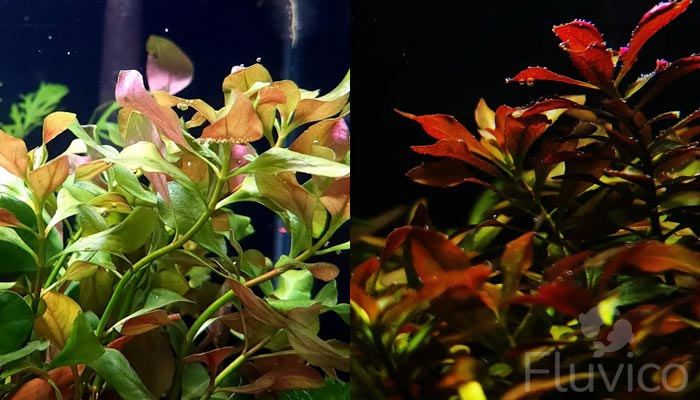
Where Does Ludwigia Repens Come From?
Ludwigia Repens is indigenous to North and Central America, predominantly thriving in wetland areas and marshes. Its adaptive qualities allow it to flourish both in submerged and emersed conditions.
Appearance
Ludwigia Repens, or Red Repens, is a striking aquatic plant with sturdy stems reaching up to 20 inches. Its oval leaves, 2-4 cm in length, display a vibrant red top and deep green underside under ideal lighting. It’s the striking colour contrast – vibrant red tops and deep green undersides – that truly captivates aquarists and makes Ludwigia Repens a standout choice for any planted tank.
(When grown out of water, it can even produce small yellow flowers!). Its fast growth, adaptability to various water conditions, and vivid aesthetics make it an excellent choice for both novice and advanced aquarists, enhancing any aquarium with its dynamic presence.
Tank Requirements and Water Parameters for Ludwigia Repens

Tank Size: Room to Grow
Ludwigia Repens is a fast-growing and robust plant that can reach up to 20 inches in height.
Consequently, it is best suited to medium to large aquariums.
A minimum tank size of 10 gallons is recommended to accommodate its growth, although larger tanks will allow the plant to truly flourish.
Beginner Tip: If you’re unsure, always go bigger! A 20-gallon tank or larger is ideal for Ludwigia Repens to truly thrive.
Water Parameters: Creating the Perfect Aquatic Environment
Water Type: Freshwater, ideally with some degree of mineral content for healthy growth.
- Temperature: Prefers warm conditions, with a range of 60-86°F (15-30°C).
- Hardness: Thrives in soft to moderately hard water, general hardness (GH) ideally between 4-12° dH.
- pH: Adaptable to a wide pH range from 5.0 to 8.0, but optimal growth usually seen in slightly acidic to neutral conditions (6.0 – 7.0).
Beginner Tip: Don’t get overwhelmed by water chemistry! For Ludwigia Repens, using standard tap water (dechlorinated) is often perfectly fine for beginners. Focus on regular water changes.
Pro Tip: For the most vibrant red colours in Ludwigia Repens, slightly softer water can be beneficial. However, it’s not essential for basic growth, and tap water is usually perfectly adequate for beginners.
Lighting: Unlocking Vibrant Red Colours
- Light Intensity: Moderate to high (around 30 to 50 PAR) for optimal growth and red coloration.
- Light Spectrum: Full spectrum aquarium lights are preferable.
- Light Exposure: Consistent exposure for about 10-12 hours per day promotes healthy growth.
- Dark Periods: Despite its light needs, Ludwigia Repens also requires periods of darkness for overall well-being.
Beginner Tip: Start with a standard LED aquarium light designed for plants. Observe your Ludwigia Repens – if it’s green, increase light gradually to encourage red colour.
Substrate: Planting the Roots for Success
- Type: Nutrient-rich substrate is ideal, such as aqua soil or clay-based substrates.
- Depth: A substrate depth of at least 2-3 inches is recommended for proper root development.
- Nutrition: Additional root tabs or fertilizer can be used to supplement nutrients, promoting healthy growth.
- Stability: The substrate should be stable enough to anchor the plant and withstand its rapid growth.
Beginner Tip: For beginners, pre-fertilized aquarium substrate is a fantastic and easy option. You won’t need to worry about root tabs right away.
Pro Tip: For long-term, dense growth, especially if you are aiming for a lush background of Ludwigia Repens, consider a substrate depth slightly deeper than 2-3 inches to provide ample root space and anchoring.
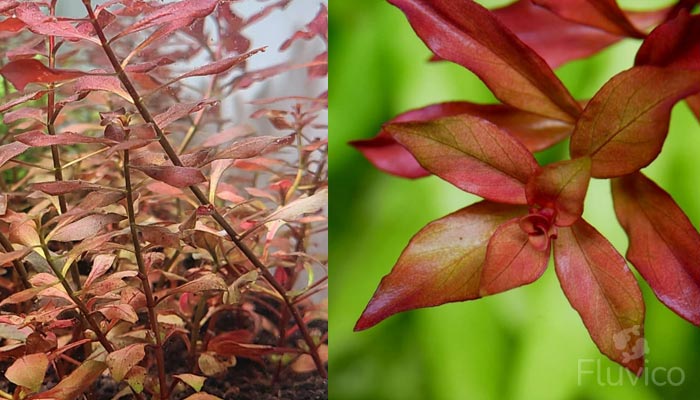
CO2 & Fertilizers: Boosting Colour & Growth – Highly Recommended for Best Results (Beginner-Friendly Options Exist)
- CO2: Supplemental CO2 is beneficial but not mandatory; levels of 20-30 ppm promote vibrant color and robust growth.
- Macronutrients: Regular dosing of Nitrogen (N), Phosphorous (P), and Potassium (K) is essential for growth.
- Micronutrients: Trace elements such as Iron (Fe) are necessary for maintaining the plant’s vibrant red coloration.
- Fertilization: Use of a comprehensive aquarium plant fertilizer can ensure necessary nutrients are provided. Regular dosing, following product guidelines, is recommended.
Beginner Tip: For beginners, focus on good lighting and substrate first. Liquid fertilizers are the easiest way to provide nutrients if you see signs of slow growth or pale leaves. CO2, while incredibly beneficial, is optional to start, and liquid carbon supplements can be a simpler alternative to CO2 injection for a boost.
Planting & Multiplying Your Ludwigia Repens: Easy Steps to Success
Planting Ludwigia Repens involves anchoring its stem into a nutrient-rich substrate, while propagation is typically achieved by cutting the stem near a node and replanting the cut piece.
How To Plant Ludwigia Repens
Planting Ludwigia Repens is a relatively straightforward process. Here’s a step-by-step guide:
- Gentle Prep: Give your new Ludwigia Repens a gentle rinse under tap water to remove any loose bits. Don’t worry if it looks a little different from the pictures – if it was grown out of water, those smaller leaves will naturally fall off as it adapts to being submerged.
- Trim if Needed: If your stems are long, feel free to trim them down a bit to around 5-7 inches. Cutting just below a leaf node (where leaves grow) is ideal.
- Planting Time: Gently push the stem into your substrate, making sure it’s anchored at least an inch deep. Tweezers can be handy for softer substrates!
- Spacing the Stems: If you’re planting more than one stem, ensure they’re spaced out sufficiently to allow for growth and spread. Around 2 to 3 inches apart is usually a good starting point.
- Maintenance: Once planted, Ludwigia Repens requires little maintenance apart from regular trimming to control its height and promote bushier growth.
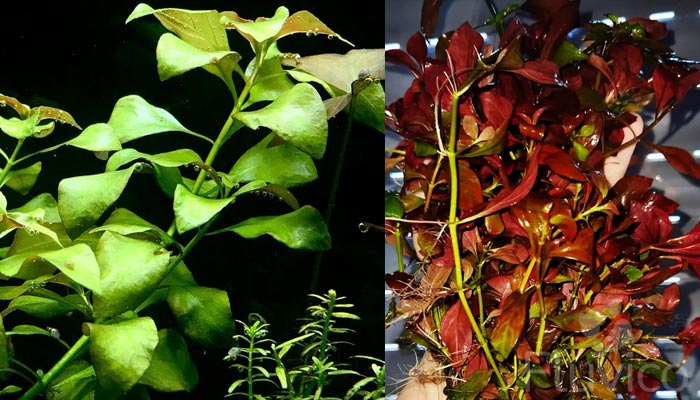
Propagation Techniques
- Cutting: Use sharp, clean scissors to cut a stem from the parent plant, preferably just below a node where leaves branch out.
- Length: The cut stem should be at least 3-5 inches long to ensure it can develop properly.
- Planting: Push the cut end of the stem into the substrate, ensuring it’s at least an inch deep for stability.
- Spacing: If planting multiple cuttings, space them 2-3 inches apart to allow for growth and spread.
- Care: Provide the new plant with the same care as the parent plant, including good lighting and nutrient-rich substrate.
Trimming & Pruning
- Monitor Growth: When it reaches the water’s surface or looks overgrown, it’s time to trim.
- Choose a Point: Identify a node (where leaves branch out) at your desired height.
- Cut: Cut the stem just above the identified node. The remaining bottom part will sprout new branches, while the cut top part can be replanted.
- Replant: Push the cut top part into the substrate, ensuring it’s well-anchored.
- Regular Maintenance: Repeat this process regularly to control the plant’s size and promote bushier growth.
Pro Tip: Don’t throw away those trimmed Ludwigia Repens tops! They are perfect for propagation. Just replant them in your substrate to create even more Ludwigia Repens plants and a bushier background!
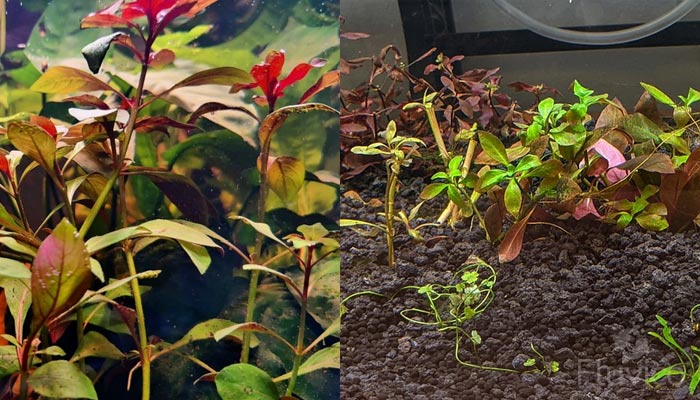
Troubleshooting Common Ludwigia Repens Issues (and How to Fix Them!)
While Ludwigia Repens is generally an easy plant to care for, there are a few potential issues that aquarists may encounter:
- Lack of Red Coloration: If Ludwigia Repens is not displaying its characteristic red color, it may not be getting enough light or nutrients. A deficiency in iron, in particular, can affect the plant’s color. Increasing light intensity and ensuring the plant is getting the nutrients it needs can help enhance coloration.
- Leaf Melt (Don’t Panic!): It can be a little alarming, but sometimes Ludwigia Repens might ‘melt’ – meaning it loses some leaves, especially when first introduced to a new tank or if water conditions change suddenly. This is often just the plant adjusting! Usually, it bounces back quickly once it settles in. Keep an eye on it, but don’t stress too much initially.
- Fast Growth Can Be a Lot (But Easily Managed): Ludwigia Repens loves to grow! This is fantastic, but it means you’ll need to trim it regularly. Overgrown plants can block light from reaching smaller plants and take over your tank. Regular trimming is key to keeping it in check and promoting bushier growth (remember those cuttings can be replanted!).
- Pests: Ludwigia Repens can occasionally be affected by pests, such as snails and certain types of algae. Regular inspection of the plant and the use of safe treatment methods can help control these issues.
- Plant-Eating Fish: Some fish species are known to eat or damage aquatic plants. Care should be taken when selecting tank mates for Ludwigia Repens.
- Nutrient Deficiencies: If Ludwigia Repens starts to show signs of poor health, such as yellowing leaves, it may be lacking necessary nutrients. Regular dosing with a comprehensive plant fertilizer can usually address this issue.
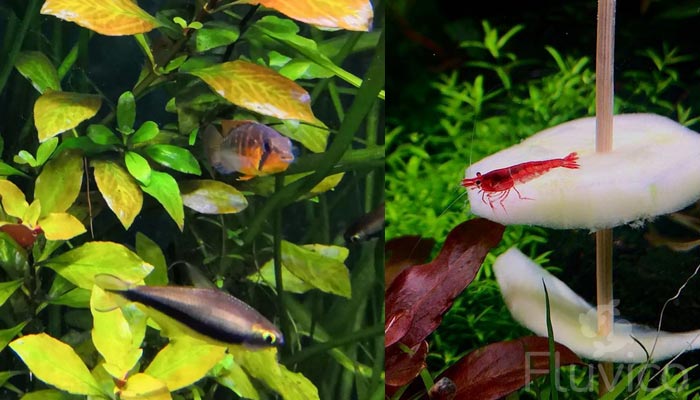
Ludwigia Repens: Perfect for Your Community Aquarium!
Compatibility and Tank Mates
- Compatible Fish: Small to medium-sized fish that are peaceful and, importantly, *don’t nibble on plants* are ideal tank mates. Examples include tetras, rasboras, guppies, mollies, platies, danios, and many species of dwarf cichlids.
- Invertebrates: Ludwigia Repens is also well-suited to tanks with invertebrates such as shrimp and snails. Both cherry shrimp and nerite snails are excellent choices.
- Aquatic Plants: Ludwigia Repens can be combined with a variety of other aquatic plants for a more diverse and attractive setup. Just make sure that it doesn’t overshadow smaller, less robust plants.
Imagine vibrant red Ludwigia Repens swaying gently in your community tank, creating a stunning backdrop for your colourful fish and invertebrates – a truly captivating underwater scene! Remember, Ludwigia Repens is a fast-growing plant that can quickly take up a lot of space, so be mindful of its potential size and growth rate when deciding on tank mates.
Bringing Home Healthy Ludwigia Repens: Buying & Quarantine Tips
Starting with healthy Ludwigia Repens is key to success! Look for plants with bright, vibrant leaves and strong stems. Avoid plants that look pale, damaged, or have signs of algae or pests. When buying Ludwigia Repens, choose plants with healthy, vibrant leaves and stems. After purchase, it’s recommended to quarantine the plant, keeping it separate in a controlled environment, to prevent any pests or diseases from being introduced into your main aquarium.
Quarantining might seem like an extra step, but it’s essential to protect your existing aquarium ecosystem from potential pests or diseases that could be hitchhiking on new plants. A little patience now saves a lot of potential headaches later! After a few days without signs of issues, it can be safely introduced to your tank. 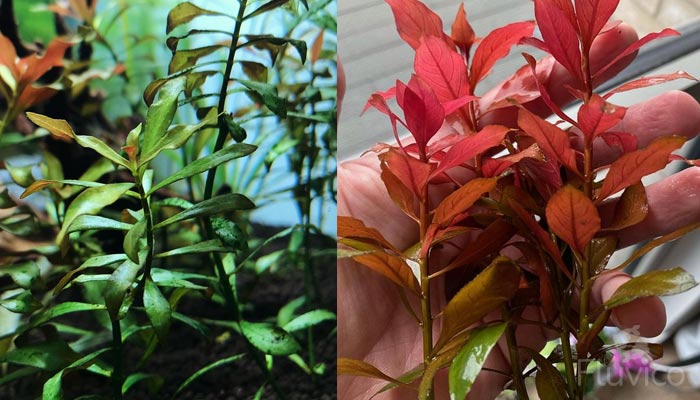
Ludwigia Repens FAQs
Is ludwigia easy to grow in?
Yes, Ludwigia Repens is considered easy to grow. It’s a robust plant that adapts well to a range of water conditions, and it has a fast growth rate, making it suitable for both novice and experienced aquarists.
Is Ludwigia A Root Feeder?
Yes, Ludwigia Repens primarily absorbs nutrients through its roots, emphasizing the need for a nutrient-rich substrate. While it can also uptake nutrients from water via leaves, its main feeding happens at the root level.
Why is my ludwigia dying
Your Ludwigia Repens might be showing signs of stress (not necessarily dying!) due to a few common reasons: insufficient light, nutrient deficiencies, or unsuitable water parameters. Other potential issues include pests, disease, or damage from plant-eating fish. Regular care and maintenance can help address these issues.
Does ludwigia repens need C02
While Ludwigia Repens can grow without added CO2, supplementing CO2 often promotes healthier, more vibrant growth and better coloration. However, good lighting and nutrient availability are also crucial for this plant’s wellbeing.
Dive Deeper into Aquarium Plants

15 Types of Cryptocoryne: Which is Best For Your Aquarium Setup?

16 Awesome Low Light Aquarium Plants (Mosses, Ferns & Stem Plants)


18 Types of Aquarium Moss: Photos, Care, Propagation & Growth Guide

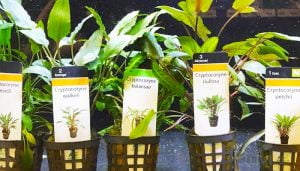
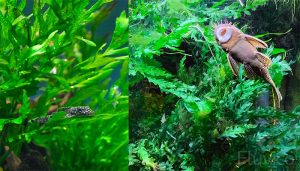
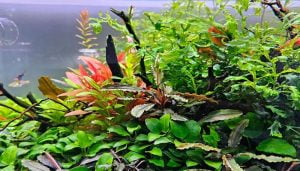


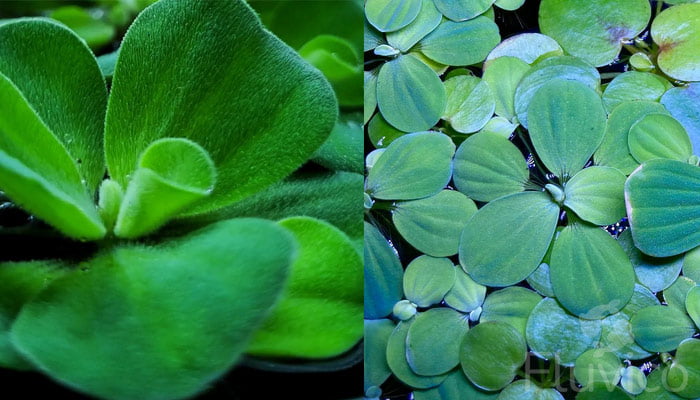
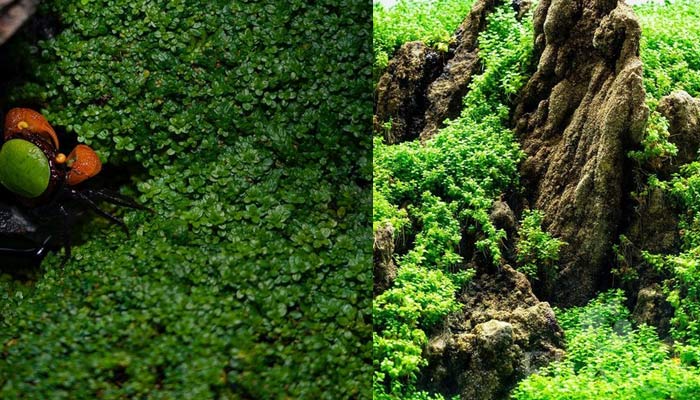

Hope you enjoyed our Ludwigia Repens Care guide!
If you have any questions? Ask away, we’re here to help!
All the best,
Daniel